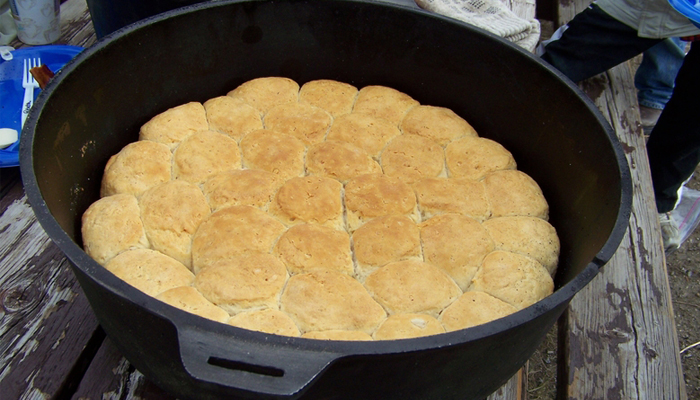
In most other English speaking countries, a biscuit is what we here in the United States would call a cookie or a cracker. The American meaning for biscuit was first noted by John Palmer in his “Journal of Travels in the United States of North America, and in Lower Canada”, (1818).
In 1828, Webster’s’ dictionary had defined the American “biscuit” as a confection composed of flour and butter, made and baked in private families (FoodTimeLine.org, n.d.).
The word biscuit is derived from the Latin words “bis” (twice) plus “coctus” (cooked). In the 1800, they were called soda biscuits or baking soda biscuits.
Baking Soda versus Baking Powder
Baking soda is pure sodium bicarbonate, and while baking powder contains sodium bicarbonate, it includes an acidifying agent (cream of tartar) as well, along with a drying agent (usually starch).
Baking soda is considered a basic and can cause a bitter taste unless countered by an acidic ingredient, an ingredient such as buttermilk, yogurt, and even honey.
Because baking powder contains cream of tartar, it is normally used in cookies and cakes and it can be used to make biscuits and bread where you would not use buttermilk, but milk, or even water instead, for example.
The “cathead” biscuit was considered an Appalachian phenomenon and many call it the precursor to the even larger size biscuits offered today by many restaurant chains. The dough was made and cooks simply pinched off a bit of dough and flattened it between their palms instead of rolling out the dough and using a cutter. Once in the pan, some cooks would poke the top of the biscuits with their fingers to keep the biscuits from “rounding” as they baked.
Cathead Biscuits
- 2 1/4 cups flour
- 1/3 teaspoon baking soda
- 1 teaspoon salt
- 2 teaspoons baking powder
- 5 tablespoons lard
- 1-cup buttermilk.
Sift and then mix your dry ingredients and then cut in your lard. Then add your buttermilk. Pinch off portions of dough the size of a large egg and pat with your hands.
Recipe courtesy of Smokehouse Ham, Spoon Bread, & Scuppernong Wine, Joseph E. Dabney [Cumberland House: Nashville TN] 1999 (p. 114-5)
Cowboy Biscuits (Baking Powder Biscuits) in a Dutch oven
Chuck wagon cooks usually made soda and sourdough biscuits and their only method of baking were Dutch ovens with a lid that were lipped so the cooks could pile heated rocks or hot coals on top for more even baking.
- 3 cups flour
- 6 teaspoons baking powder
- 3 tablespoon fat (lard or bacon drippings)
- 1 cup of milk
- 1 teaspoon salt
- 1 tablespoon sugar
The dry ingredients are sifted together, and then the lard is worked in with the fingertips, until flaky.
Add your milk to moisten and then turn out onto a well-floured board and pat to about 1/2 inch thickness.
Cut with biscuit cutter and place in a well-greased Dutch oven that has been slightly preheated. Biscuits should be touching but not crowded.
Place the preheated lid on the oven and cover with hot coals. Place on a bed of good red coals and let bake about twenty minutes or until brown on top and bottom.
(Clair Haight, Hashknife Outfit, Winslow AZ, 1922 (reprinted in: Chuck Wagon Cookin’, by Stella Hughes [University of Arizona Press: Tucson AZ] 1974 (p. 123))
Biscuits served as sandwich bread when bread was not made or simply unavailable. Ham, bacon, sausage, mutton, and beef were staples for sandwiches, and a condiment might have been chuck wagon pickles, made by letting cucumbers soak in a glass gallon jug of vinegar for 8 or 10 hours in the sun. Anyone traveling in the west usually had a supply of biscuits as part of their provisions.
Travelers would stop at homesteads and ranches as they moved about, and the cooks usually supplied weary travelers with a meal and a small flour sack of biscuits and cured ham or bacon for the trail.
A biscuit served up with gravy was often times the entire meal, because gravy usually had some meat in it like sausage or ham, or at the very least, the pan drippings from fried ham or sausage were used to make the gravy